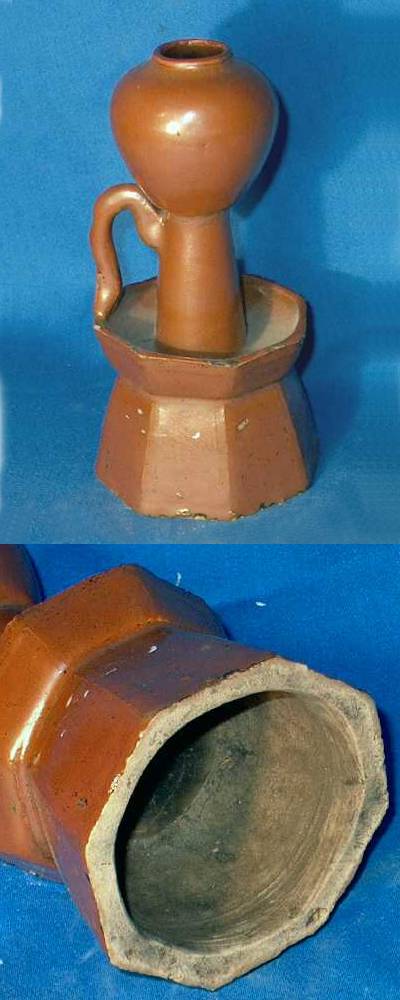
This page is only one of many thousands of Gotheborg.com Help and Information Pages, offering specialized knowledge on Chinese and Japanese Porcelain, including a Glossary, Q&A, Chinese and Japanese Porcelain Marks, Chinese Porcelain Exhibition and Excavation reports etc. For personal help and far more information, join our Discussion Board or use 'Ask a Question' for quick email consultations. For full text and better navigation, use a full-screen device rather than a mobile phone, that offers only limited content.
 I found your web site while searching for data on antique Asian oil lamps. Recently I got an object I think is a Chinese oil lamp,
I found your web site while searching for data on antique Asian oil lamps. Recently I got an object I think is a Chinese oil lamp,
I enclose two pictures of it. It's 18.5 cm tall, 10 cm wide at the base. The central column is hollow. There's a 4 mm hole in the central column, under the handle at a height just above the lip of the trougth.
The upper bowl has no holes other than the one on top. If it were American I'd say it was a country piece.
I have a Japanese rural oil lamp that's similar to this one, but the top is much more open (like a birdbath.) The wick is a stiff reed & just lies in the oil - hangs a bit over the edge - any drips are caught in the base bowl.
Any help you can give me will be appreciated :)
As far as I can tell this seems to be a South Chinese oil lamp. Normally an oil lamp would have been expected to have some kind of holder for a wicker, but South Chinese oil lamps seems to have managed without. It sounds quite likely that a reed similar to the one on your Japanese lamp was used, but I really don't know.
The only actual explanation I have heard for how these oil lamps were used, was just to pour oil in them and light it. This sounds dangerous to me but maybe they had something figured out, or used some kind of special oil which did not evaporate much when the lamp got hot.
There are similar - more open - lamps in green glazed clay which are more common.
As for where and when this lamp was made, is very hard to tell. If it indeed are Chinese at all it should be somewhere along the southern coast of China.
If we were to pinpoint a location, my personal guess would be a old kiln site close to Canton, called Shiwan. This is an old and well known place on an island in the Pearl River delta. Best known for their pottery figures but they made other kinds of pieces too.
Other possible location are further east in the Fujian, Yixing or Dehua area due to the plasticity we can see in the shapes, but I personally would cast my vote on Shiwan anyway.
The clay which is seen within the base is very characteristic when you have seen a few and this definitely belongs to a large group that we would really be able to identify by now, but as far as I know there are no excavation data to support any of the locations.
As for a date I personally don't think this lamp is as old as it looks. It might very well have been made for some eastern export market. Since the Asian economic development in South East Asia got momentum only in the early 18th century, with the demise of the western East india companies, I am thinking of Malacca and the Islamic areas all the way up to the Middle East, where the coffee pots we see today have this kind of bases.
Some of the pieces with this kind of clay could actually have been made well into the 1950s, and China being what it is when it comes to light fixtures there is no telling how old this is. Not much have really changed on the South Chinese country side since Marco Polo. So, if I were to suggest a date I would until further say probably mid 19th century, plus minus 100 years and with an earliest possibly date around early Qing.
So far, this will have to do.
Thank you for your interest.
Best regards,
Jan-Erik Nilsson